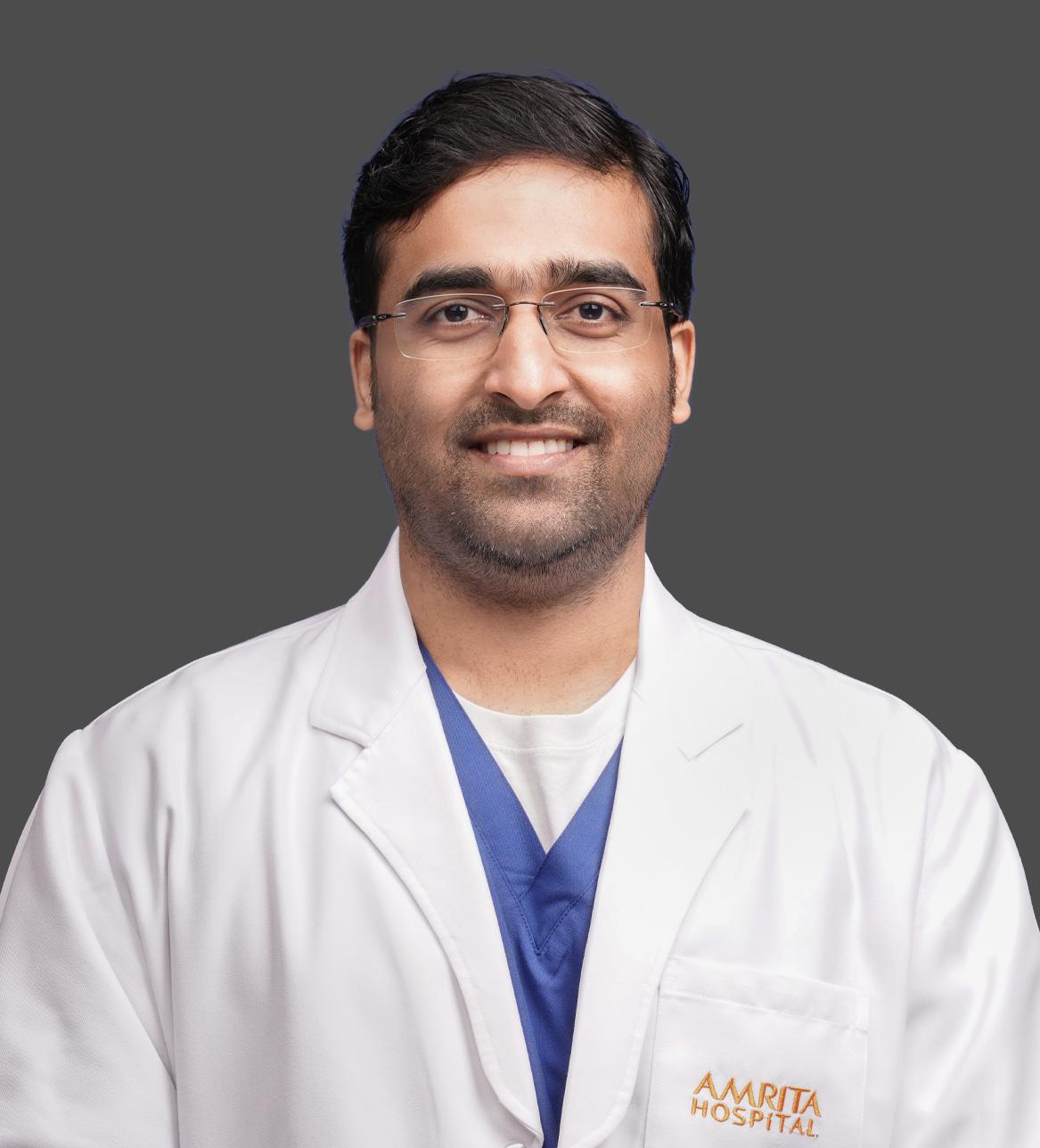Organ Transplantation Care at Amrita Hospitals, Faridabad
The Department of Solid Organ Transplantation and HPB Surgery (Liver Transplantation) brings 25 years of experience in the field of Organ Transplantation, Complex Liver Resections and Biliary Tract Surgery to Amrita Faridabad.
The Solid Organ transplant team has the experience of doing high volume liver, pancreas and intestinal transplantation in the Amrita Institute of Medical Sciences, Kochi, having performed over 1400 Liver transplants.
With robotic donor surgery being accepted worldwide as an innovation with potential to reduce donor morbidity we are proud to say that we performed India’s first fully robotic donor hepatectomy and is the second leading center worldwide in robotic liver transplant having successfully done over 350 Robotic Donor hepatectomies till date. We are in addition one of the nation’s leaders in minimally invasive and Robotic HPB surgery.
Diseases Treated
Liver diseases:
- Decompensated End Stage Liver disease
- Acute Liver failure
- Acute on Chronic Liver Failure
- Pediatric Liver Diseases
- Liver tumors
- Complex Liver trauma
Biliary diseases:
- Gall Bladder Cancer
- Bile Duct Cancer (Cholangiocarcinoma)
- Biliary strictures
- Choledochoal cysts
- Complex biliary cysts
- Gall bladder stones
- Biliary injuries
Pancreatic diseases:
- Pancreatic Cancer
- Chronic pancreatitis
- Pancreatic cysts
- Pancreatic necrosis
- Pancreatic trauma
Shunt surgery for portal hypertension
Service
Liver:
- Liver transplantation (cadaveric and live donor )
- Complex liver transplants like ABO incompatible, Swap, Domino, Simultaneous Liver-kidney and APOLT.
- Laparoscopic complex liver surgeries.
- Robotic major liver surgeries (Davinci Xi system)
- Open Complex liver surgeries
- Surgery for complex liver cysts
- Surgery for liver trauma
Biliary:
- Laparoscopic biliary surgeries
- Robotic biliary surgeries(Davinci Xi system)
- Open biliary surgeries
- Laparoscopic and robotic cholecystectomy
- Laparoscopic radical cholecystectomy
Pancreas:
- Pancreatic transplantation
- Open, Laparoscopic and Robotic whipples resection
- Open, Laparoscopic and robotic pancreatic resections
- Open, Laparoscopic and robotic Median pancreatectomy
- Surgery for chronic pancreatitis
- Surgery for pancreatic trauma
- Surgery for pancreatic necrosis
Other services:
- Intestinal transplantation
- Complex abdominal vascular surgeries (Mesenteric revascularization, Abdominal shunt surgery)
Dedicated Special Clinics for Comprehensive Transplant Support
Liver Clinics (Tuesdays and Fridays): Multi-departmental counseling on treatment options and preventive aspects of liver related illness. (Hepatologist, Transplant Surgeon, Dietitian, Social worker)
Multi-disciplinary tumor board (Mondays and Thursdays): Multi-departmental clinics for care of cancer patients management pathways.
Post-Transplant clinics: This clinic focusses on routine comprehensive follow up of post-transplant patients.
Why choose us
We believe that the burden of liver diseases can be addressed only by preventive strategies. However, if the disease is far advanced then the patient and family will be counselled on the treatment options available, the benefits and risks involved with each treatment pathway and the family will be given advice and support. We would respect patient autonomy but awareness on the risks and benefits would help decision making.
We have the best supportive care services which involves the latest diagnostic technology, experienced and dedicated nursing services, Physiotherapists, Nutritional experts, and of course a world-class multidisciplinary Transplant team.
What we offer
Patient listening and arriving at the correct decision by involving all the specialists involved including the Primary care specialist at all steps of the patient’s treatment pathway.
Our Philosophy
To provide the best possible care whilst being a friend to the patient and family in their times of need.
Academics
Fellowship Program
FAQs
The liver has many jobs to do such as to helping to digest your food, clearing some wastes from your blood, making proteins that help your blood to clot, storing glycogen for energy, breaking down many poisons and medicines and many more tasks. When the liver is seriously damaged, there is no treatment that can help the liver do all of its jobs. Therefore, when a person reaches a certain stage of liver disease, a liver transplant may be the only way to prolong his or her life.
The most common reason for liver transplantation in adults is cirrhosis, a disease in which healthy liver cells are killed and replaced with scar tissue. The common causes of cirrhosis are alcohol abuse and hepatitis due to B and C viruses. The most common reason for transplantation in children is biliary atresia, a disease in which the ducts that carry bile out of the liver are damaged.
Liver transplant may also be done for some type of liver cancers.
The liver only starts to fail when more than half of it is damaged. Once a person shows signs of liver failure, it means there is not much of the liver left for the body to rely on. Signs of liver failure may include the following:
Yellow skin and eyes (jaundice)
Forgetfulness, confusion, or even coma (encephalopathy)
Feeling very tired (fatigue)
Build-up of fluid in the stomach (ascites)
Vomiting of blood from veins in the oesophagus and stomach (haemetemesis).
Muscle wasting
Poor clotting of the blood
If the doctors believe that a patient with liver failure is not likely to live for one more year, he or she will become a candidate for liver transplantation. This is, however, a very complex issue and must be answered on a case-by-case basis. You must first undergo a variety of laboratory tests, x-rays, and consultations. You will need to be admitted to the hospital for approximately one week to carry out these tests. Once they are completed, your test results are reviewed at the Liver Transplant Committee meeting made up of doctors, nurses, transplant coordinators, psychologists, and social workers. This is to help us decide whether a liver transplant is the best choice for you.
If you are found to be appropriate for a transplant, you will be placed on the waiting list for a liver transplant. Once in a while, patients are found to be too healthy for a transplant. These patients may then be followed closely for signs of more liver failure. As their liver gets worse, they will be retested and if suitable may be placed on the liver transplant list at that time. Other patients may be too ill to survive the transplant. In these cases, the committee will not approve a liver transplant.
The survival rate after liver transplant is more than 80% at one year, and 70% at five years. This implies that if 20 patients undergo liver transplantation, within one year 4 will die due to the complications of the operation or its medications. Within 5 years four more out of these 20 are likely to die due to a variety of problems.
If you compare this with the results of operation for most cancers, this is an exceptionally good end result. It is particularly so, given that without a liver transplant most patients would have died within a year.
No one knows how long a transplanted liver can last. The longest-reported survivor is 25 years. Ten-year survival is common. Hopefully, improvements in techniques and medications that are continually occurring will allow most patients receiving liver transplants today to have long productive lives.
However, you must have completely stopped taking alcohol for a minimum period of one year. You will be assessed by a psychologist and a psychiatrist to establish whether your mental, social and family environment may drive you to alcohol following a successful transplant. Even small amounts of alcohol after a liver transplant can seriously damage the new liver.
Hepatitis C and B viruses can live in cells other than in the liver. Once the old liver is removed and the new one is connected the hepatitis virus spreads back into the liver within the first weeks to months after the transplant. It is almost certain to occur with Hepatitis C. This is the bad news: at present we have no way to make the hepatitis C virus go away completely. The good news is that overall results with hepatitis C after liver transplantation is good because although the disease comes back it does not seem to greatly damage the liver in the majority of cases. Occasionally, it is possible for the hepatitis to return so severely that the new liver fails very soon, but this is uncommon.
Fortunately hepatitis B can be treated more effectively, however it is very expensive.
There are two types of donors.
Cadaver donor: In this case, the donor's liver is obtained from a person who is diagnosed as “brain dead” and whose family volunteers to donate the organ for transplantation. Cadaveric organ donation from brain-dead patients remains the principal form of donation in most parts of the world. “Brain death” usually results from head injury, stroke, brain haemorrhage, etc. Such donors are on a ventilator in a hospital intensive care unit. Although their heart continues to beat and keep their blood circulation going, they are clinically dead. Because the ventilator provides oxygen which keeps the heart beating after death, they are called heart-beating brain-dead donors. If their breathing support machines were stopped, the heart would stop immediately. Even on a ventilator, they are unlikely to survive more than a week. In these circumstances death is confirmed by brain stem death tests, which are recognized all over the world and by the Indian parliament (Transplantation of the Human Organs Act, 1994). Whilst their heart is beating on the ventilator, their organs can be removed for transplantation into a recipient.
Living donor: Recently, living-donor liver transplants have become more common, particularly in Asian countries such as Japan, Korea, Taiwan, Singapore, etc where for various reasons, cadaveric donors are very few in number. A healthy family member, usually a parent, sibling, child, or spouse may volunteer to donate part of their liver for transplantation. For an adult who needs a liver, the right half of the liver is removed from the donor and used for the transplant. For a child who needs a liver, a smaller part of the liver (part of the left side) is removed from a living donor for the transplant. The donor is carefully evaluated by the team to make sure no harm will come to the donor or recipient.
Once a suitable donor is found, you will be contacted instantly and you will need to reach the hospital at the earliest. We will therefore need a list of the names and telephone numbers of people who will know where to reach you.
There are many problems that may come up during the waiting period. You may need to be seen by our doctor regularly. You should have your blood tested and your medicines changed as necessary to keep you in the best possible shape for a transplant. It is very important that you keep all your appointments.
Liver transplant is a major operation taking about 6 to 12 hours to perform. Following the surgery, you will be in the transplant intensive care unit for about 2 to 3 weeks. There will be intensive monitoring of your liver, kidney, heart function, etc during this period. Subsequently, you may go to the ward till your discharge. Generally, you are expected to be in the hospital for about 4 to 6 weeks after the operation.
The two most common complications following your liver transplant are Rejection and Infection. These complications are most common in the first year following your transplant.
Rejection: Your body’s immune system is designed to destroy foreign cells such as bacteria and viruses, which are harmful to you. Your immune system attacks the cells of the new liver because they’re not like your body’s own cells. This attack is called “rejection,” the most serious problem that can happen after a transplant. To prevent rejection of the new liver, you need to take anti-rejection medicines called “immunosuppressants”. Examples are tacrolimus, cyclosporine, azathioprine, mycophenolate, prednisolone etc.
Approximately 50% of liver transplant recipients experience at least one episode of rejection. Usually, this rejection episode resolves completely with treatment. If you do not take your medication properly as instructed, your chances of rejection are higher.
Infection: Microorganisms called bacteria, viruses, protozoa, and fungi cause infections. Because you will be taking immunosuppressive medications that suppress your immune system, you will be at risk of acquiring infections from these microorganisms. Some of these organisms live normally in the body and do not produce illness before your transplant. Once you are transplanted and the immune system is suppressed, these organisms could trigger infections. Hence monitoring for infection is extremely important for the newly transplanted patient.
Soon after a liver transplant, typically you will be given three antirejection pills, as they work better in combination. Later it may be reduced to two or even one. These medicines weaken your immunity just enough so your body accepts the new liver. They are very strong medicines but without them you will lose your new liver.
As explained above, the main side effect of these medicines is infection. You will therefore be given drugs to prevent acquiring viral, fungal and protozoal infections. Any bacterial infections will be treated accordingly as recommended by the transplant team.
The other side effects are:
Transplant medicines can make you more likely to get some type of cancers like cancer of lymph glands and skin. The doctors will try to adjust the dose of the medicines so that you do not get infections or cancers. Furthermore, you will be regularly checked for the development of cancers. Most of these cancers are easily treated, if detected early. Nevertheless 1% of transplant recipients die of cancer.
Diabetes, high blood pressure, weight gain, high cholesterol, weak bones, hair thinning etc are other relatively minor side effects. These can be detected early and appropriate treatment started to prevent any major issues.
You will need to attend the outpatient department regularly for a check-up by the doctor and for testing your blood. Initially, you will have to visit 2- 3 times a week; later once a week and then less often. The better you look after your new liver, the longer it will last for you, and the lesser the side effects of medications.
Living-donor transplantation entails the removal of a portion of the donor’s healthy liver into another person who is in need of transplantation (recipient). A family member, usually a parent, sibling or adult child (above the age of 18 years) or someone emotionally close, such as a spouse, may volunteer to donate a portion of their healthy liver. This procedure is made possible by the liver’s unique ability to regenerate. After transplantation, the partial livers of both the donor and recipient will grow and remodel to form complete organs.
Yes. Cadaveric organ donation from brain-dead patients remains the principal form of donation in most parts of the world.
Due to the success of organ transplantation, there are a large number of patients waiting for transplants. Unfortunately, there is insufficient number of donor organs available. Hence most have to wait a long time before a suitable organ becomes available to them. During this waiting period, there is inevitable deterioration of the liver disease. In many cases, patients may die without ever getting an organ for transplant.
The principal advantage of living-donor transplantation is that it provides immediate organ availability to those awaiting transplantation. The timing of the transplant operation can be planned and the progression of recipient’s liver disease and its life-threatening complications can be avoided. Living-donor transplantation offers the possibility of earlier transplantation to those in need, before their health deteriorates to life-threatening status. This is particularly valid in Asia, where for a variety of reasons cadaveric organ donation is extremely infrequent.
Living-donor transplantation was first performed in children as a means to alleviate long waiting times for cadaveric organs. Here less than a quarter of the adult liver needs to be removed for transplantation into a child. This proved to be a very successful procedure all over the world with very little danger to the donor. However, adults in need of liver transplantation require a larger segment, as much as half or more of the donor’s liver. This requires a more extensive and complex surgery, with potentially greater risks for the donor. Now adult to adult living donor transplantation has become customary in most parts of the world, but particularly so in Asian countries like Japan, Korea, Taiwan, India etc where cadaveric donation is uncommon.
Potential liver donors are carefully evaluated to select those individuals who can safely donate a portion of their liver which will function immediately. The primary concern throughout the evaluation is the safety of the donor. This means that if transplant physicians estimate the risk of death for a donor could exceed 1%, that person would not be permitted to donate. General criteria for liver donation include:
good general health.
blood type compatible with recipient’s blood group.
having a solely altruistic incentive for donating.
A living-donor candidate must complete the following evaluation process to determine if they can safely donate part of their liver:
The first testing determines if the donor’s blood type is compatible with that of the recipient. Additional blood tests are performed to test for healthy functioning of the donor’s liver, kidneys, heart, lung and thyroid, and to screen for exposure to viruses that transmit diseases such as hepatitis and AIDS.
Abdominal ultrasound testing is performed to screen for abnormalities of the liver and other abdominal organs and blood vessels.
CT scans and Magnetic Resonance Imaging (MRI) are performed to create detailed anatomical “road map” of the donor’s internal organs to decide how much of the liver would be required for the recipient and to aid the surgery.
Usually additional testing, such as pulmonary function testing, echocardiogram, exercise stress testing etc. is necessary to authenticate the wellbeing of the donor.
The standard time required to complete the donor evaluation process is two to four weeks. If necessary, however, it can be completed in as little as 48 hours.
Depending on which part of the donor’s liver is removed, the incision is usually in the shape of an inverted “T.” Typically for right lobe donation, the gallbladder needs to be removed. The donor’s liver is carefully split into two segments and one portion is removed for the recipient. The wound is then closed securely: the skin stitches typically being done with absorbable sutures which do not require removal. The liver begins to heal and regenerate itself, generally taking six to eight weeks for full regeneration.
Typically, a donor remains in the hospital from five to ten days after surgery. Donors spend their first night after surgery in the Surgical Intensive Care Unit for close monitoring by specialized nursing staff. The following day, they are usually transferred to the general surgical floor where the nurses are specially experienced. Donors are encouraged to get out of bed and sit in a chair the day following surgery, and to walk the corridors as soon as they are able.
Every donor’s recovery time is different but, typically, donors spend four weeks recuperating after surgery. In the month following discharge from the hospital, donors return weekly or fortnightly for outpatient monitoring. Individual recovery rate and the type of occupation dictate how soon a donor can return to work, but it commonly averages three to six weeks.










